Birds of prey are known for their hunting ways and mainly eat other animals or leftovers from other animals. They can be of different colors and sizes. They have strong features like quickness, power, sharp eyesight, strong claws, and strong beaks. Some of these birds can be white. This white color happens because of a substance called melanin. Melanin usually makes things black, but in these birds, there’s less of it, making their feathers white. Examples of white birds of prey include the white hawk, snowy owl, king vulture, osprey, gyrfalcon, letter-winged kite, Egyptian vulture, and more. Some of them have black tips on their wings – this is because melanin, that dark color stuff, makes the feathers tough and resistant. Look at their pictures and learn some fun facts about them!
List of 22 Species of White Birds of Prey
Snowy Owl

Image Source
- Scientific name: Bubo scandiacus
- Life span: up to 9 years in the wild
- Size: length of 20-28 inches, wingspan of 49-59 inches
- Weight: 3.5-6.5 lbs
- Origin: Arctic regions of North America, Europe, and Asia
The Snowy Owl is an enormous white bird of prey native to the Arctic region of North America. It is the heaviest owl in North America and has a longer wingspan than any other owl found there. Females are larger than males, with some weighing as much as 6.5 pounds and spanning up to 6 feet across the wings. Snowy owls are diurnal birds, hunting during the day, especially in summer, and their diet includes small mammals, water birds, fish, and even carrion. They are monogamous and mate for life, with females laying 3-11 eggs in a ground nest.
White-tailed Kite

Image Source
- Scientific name: Elanus leucurus
- Lifespan: 6 years
- Size: 14.5 inches
- Native to: The Americas, breeding as far south as Chile and Argentina. A closely related and very similar species, the Black-shouldered Kite, occurs across Europe, Africa, and Asia.
The White-tailed Kite is a small raptor with narrow pointed wings and a long tail, mostly white in color. They are found in western parts of North and South America and are common in open woodlands, marshes, savannas, and desert grasslands, where they feed on mice, snakes, small mammals, birds, and insects. They are known for hovering over open areas while searching for prey. Outside the breeding season, they roost communally in groups of over 100 birds on just a few trees.
White Hawk
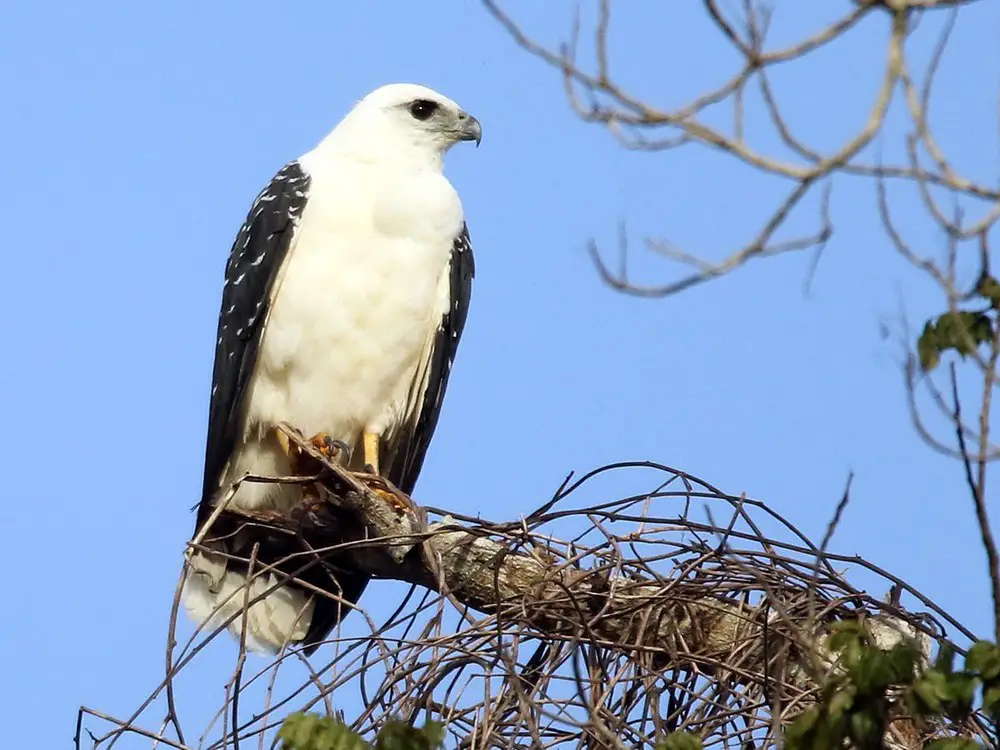
- Scientific name: Pseudastur albicollis
- Lifespan: Typically 10-15 years
- Size: Medium-sized raptor; around 17-20 inches (43-51 cm) in length, wingspan of 3.5-4 feet (107-122 cm)
- Origin: Found in parts of Central and South America, primarily in forested habitats.
The White Hawk is a stunning short-tailed hawk found in Mexico, Central, and South America. They measure from 18 to 22 inches in length and weigh from 1.4 to 1.8 pounds. White hawks have very broad wings and white plumage with black feathers on the wings and tails. They inhabit lowland forests and woodlands, ranging from southern Mexico to Brazil, Bolivia, and Peru. White Hawks are carnivores and feed on lizards, snakes, insects, and small mammals.
Egyptian Vulture

- Scientific name: Neophron percnopterus
- Lifespan: About 25-30 years
- Size: Medium-sized vulture; roughly 26-30 inches (66-76 cm) in length, wingspan of 66-71 inches (168-180 cm)
- Origin: Found in southern Europe, Africa, and Asia
The Egyptian Vulture is a small bird of prey found in Europe, Africa, and Asia. They are white with black wing feathers and naked yellow faces. Egyptian vultures are known for using tools, such as rocks as hammers to break eggs and sticks to gather and roll wool for their nests. They inhabit open and semi-open areas and mostly nest on cliffs. Their diet consists of carcasses, waste, carrion, frogs, insects, and reptiles.
Gray Goshawk
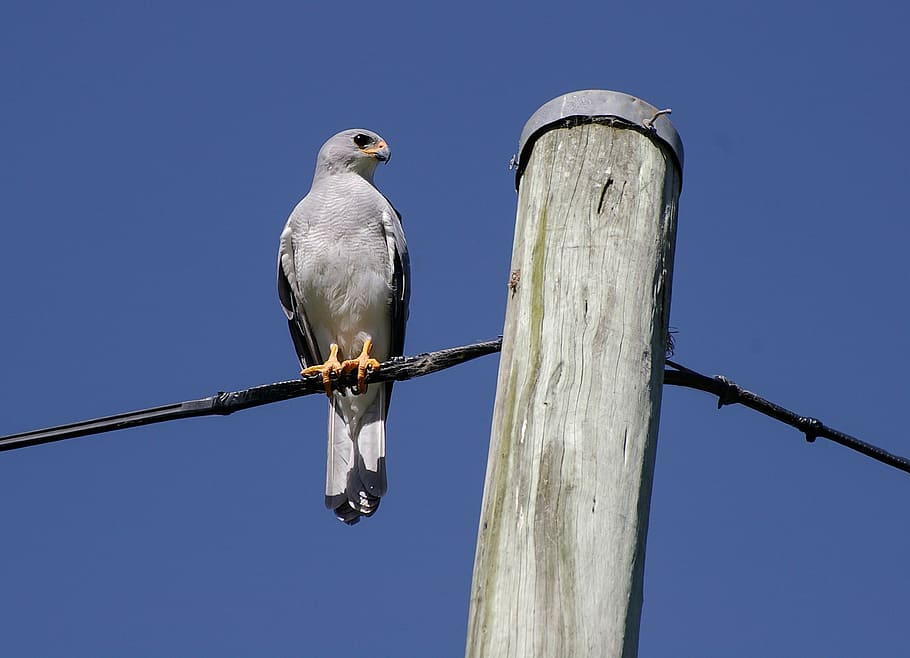
- Scientific name: Accipiter novaehollandiae
- Lifespan: Typically 7-15 years
- Size: Medium-sized hawk; approximately 16-24 inches (41-61 cm) in length, wingspan of 30-40 inches (76-102 cm)
- Origin: Native to Australia and nearby islands.
The Gray Goshawk is a medium-sized raptor found in Australia. They come in two morphs, the all-white morph known as the white goshawk and the gray-and-white morph. They inhabit forests and tall woodlands along the coast of Australia and Tasmania and have a diet consisting of birds, rabbits, bats, possums, small reptiles, and insects. Gray goshawks are monogamous and pair for life, nesting in tall trees and laying 2-3 eggs that the female incubates.
King Vulture
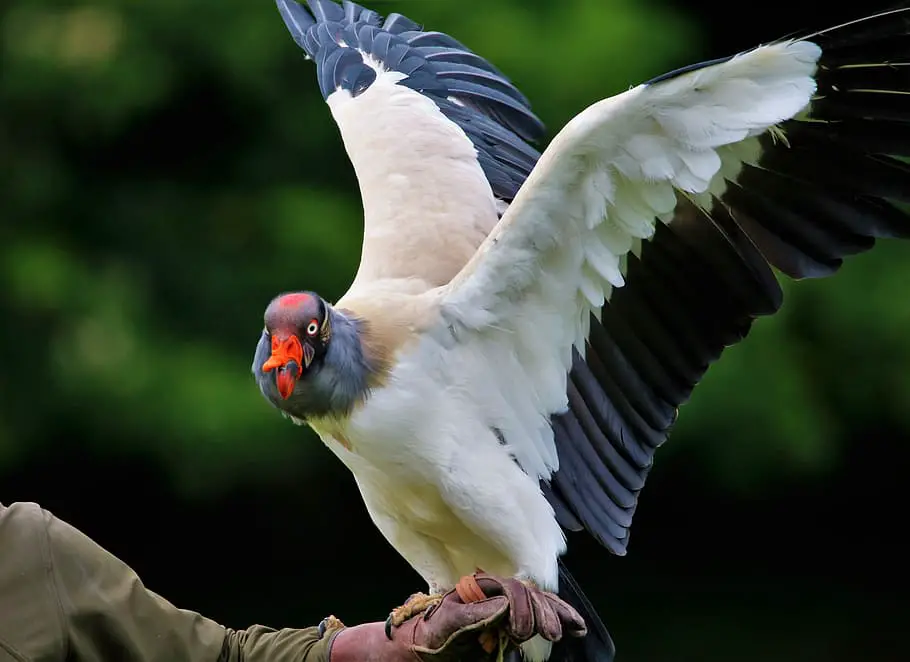
- Scientific name: Sarcoramphus papa
- Lifespan: Around 30-35 years
- Size: Large vulture; about 27-32 inches (69-81 cm) in length, wingspan of 5.5-6.5 feet (168-198 cm)
- Origin: Found in parts of the Americas, primarily in Central and South America.
The King Vulture is a large and spectacular-looking bird of prey found in Central and South America. They inhabit lowland tropical forests and range from Mexico down to Argentina. King vultures are huge and predominantly white raptors with bald colorful heads and necks, white eyes, and black edges on their wings and tails. They are strictly scavengers and soar high over the forest, searching for carcasses. They use their size to drive away smaller vulture species before enjoying their meal. King vultures are the third largest New World vultures, after the Andean and Californian condors.
Laughing Falcon
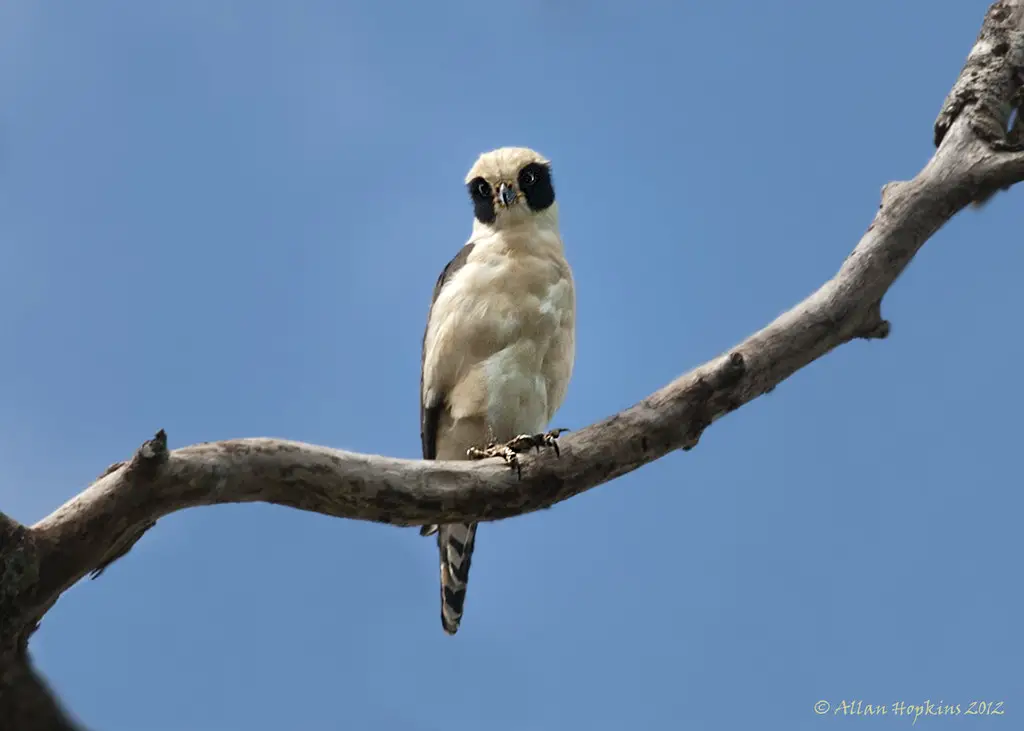
- Scientific name: Herpetotheres cachinnans
- Lifespan: Typically 7-10 years
- Size: Medium-sized raptor; around 17-22 inches (43-56 cm) in length, wingspan of 35-40 inches (89-102 cm)
- Origin: Native to Central and South America.
The Laughing Falcon is a medium-sized falcon found in Mexico, Central, and South America. They have creamy white heads with black “bandit masks,” dark brown upper parts, black and white tails, and yellow legs. The species is named after their distinctive and loud laughing call. Laughing falcons inhabit open forests and edges, palm savannahs, and second-growth in the mentioned regions. They are carnivores and have a diet consisting of snakes, lizards, rodents, fish, and bats.
Black and white hawk-eagle

- Scientific name: Spizaetus melanoleucus
- Lifespan: Up to 42 years
- Size: 20–24 in
- Native to: southern Mexico to eastern Peru, through Brazil and northern Argentina.
The Black-and-white Hawk-eagle is a small bird of prey found in lowland mixed forests and shrublands of Mexico, Central, and South America. Adults have white bodies, necks, chests, and heads with black crowns, dark upperparts, and bright orange-yellow legs and feet. They are carnivores and have a diet consisting of birds, mammals, reptiles, and amphibians. Black-and-white hawk-eagles hunt by soaring at great heights and diving rapidly with folded wings after detecting their prey. They build their nests in the forest canopy, use sticks, and lay a single egg that females incubate while males feed them. Their population is considered to be declining due to habitat loss.
Black-winged Kite
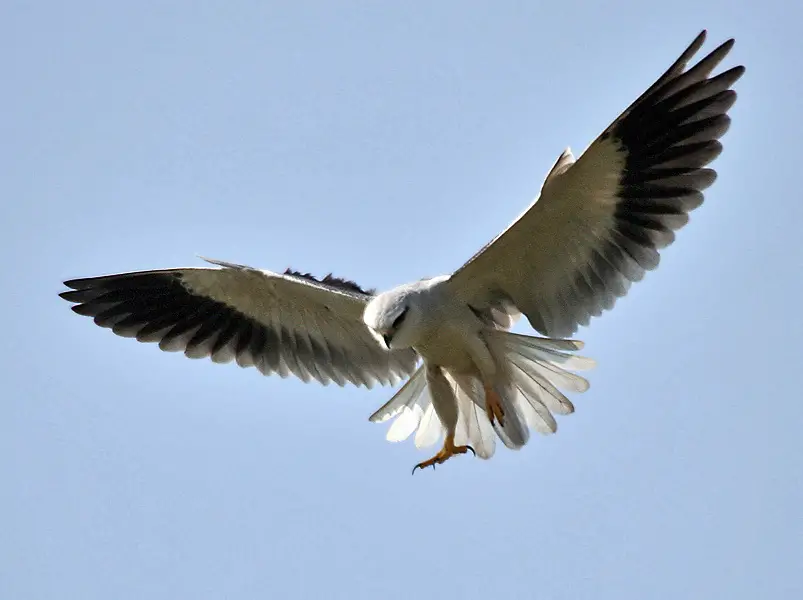
- Scientific name: Elanus caeruleus
- Lifespan: About 5-10 years
- Size: Small raptor; roughly 13-15 inches (33-38 cm) in length, wingspan of 2.8-3.3 feet (85-100 cm)
- Origin: Found in parts of Europe, Africa, and Asia.
The Black-winged Kite is a large white raptor with dark shoulder patches, wing tips, and eye stripes. They have forward-facing red eyes and long falcon-like wings that sit beyond the tails when perched. Black-winged kites inhabit open savannahs, semi-deserts, and agricultural lands in sub-Saharan Africa, South Asia, and Europe. They are territorial and protect their areas from competition. These birds are mostly solitary or found in pairs during the day but roost in groups of hundreds at night. They are noisy during courtship, and females do most of the nest-building. They lay a clutch of 3-4 creamy eggs with red spots that both parents incubate. Black-winged kites are carnivores and feed on insects, lizards, rodents, small snakes, frogs, and some birds.
Black-faced hawk

- Scientific name: Leucopternis melanops.
- Lifespan: about 15 years
- Size: 21-inch
- Native to: lowland Peru north of the Amazon and northeastern Ecuador to Venezuela, southern Colombia, Brazil north of the Amazon, and the Guyanas.
The Black-faced Hawk is a conspicuous medium-sized hawk with black and white plumage. They have large white heads with black masks and black backs with a single white band near the tails. Black-faced hawks resemble white hawks but are smaller, have different head patterns, and different beak colors. They emit high-pitched “peeoh” calls during the breeding season. These hawks inhabit lowland forests and forest edges along rivers and mangroves in South America. They are carnivores and feed on reptiles such as lizards and snakes, insects, and invertebrates.
Swallow-tailed kite (blackbird with a white belly)

- Scientific name: Elanoides forficatus
- Lifespan: about 6 years
- Size: 24-inch
- Native to: southeastern United States to eastern Peru and northern Argentina
The Swallow-tailed Kite is a white bird of prey known for its long, forked tail. They are medium-sized broad-winged raptors commonly found around marshes, fields, farms, and wooded and urban areas of North, Central, and South America. Swallow-tailed kites have unmistakable long black tails, long wings, and bold black-and-white plumage. They are omnivorous and feed on snakes, lizards, frogs, large insects, small birds, eggs, small mammals, and some fruit.
Ferruginous Hawk:

Image: Source
- Scientific name: Buteo regalis
- Lifespan: 8-10 years
- Origin: Native to North America
- Size: Length 22-27 inches, wingspan 53-56 inches
The Ferruginous Hawk is a large raptor found in the open country of North America. They are one of the largest North American raptors and have reddish-brown plumage. They come in two morphs – light-morph with rusty-brown upperparts and dark-morph with dark brown plumage overall. Ferruginous hawks breed in grasslands and sagebrush and have a clutch of 4 whitish eggs with red-brown spots. They are carnivores and feed on rabbits, hares, pocket gophers, ground squirrels, and prairie dogs.
Gyrfalcon
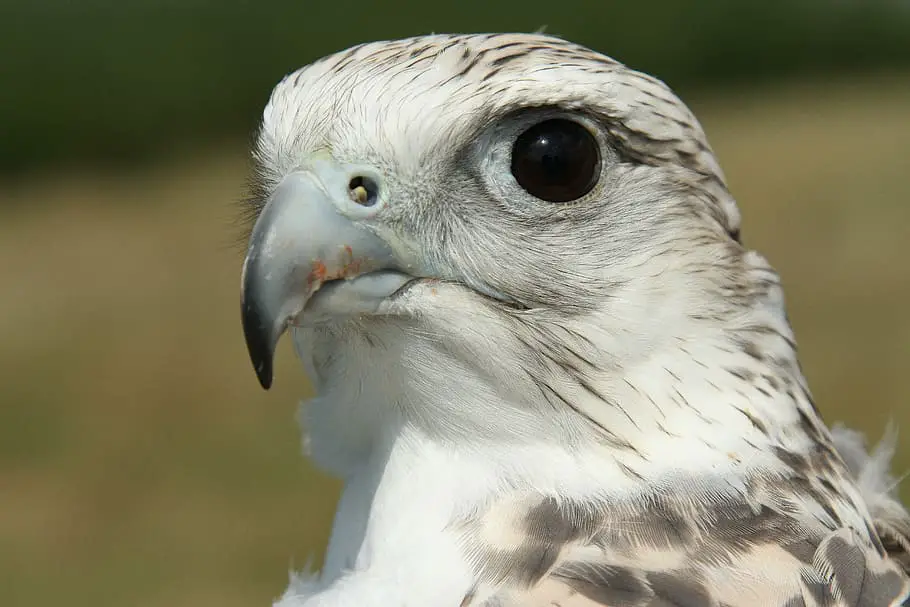
- Scientific name: Falco rusticolus
- Lifespan: Around 10-20 years
- Size: Large falcon; approximately 19-25 inches (48-63 cm) in length, wingspan of 3.3-3.9 feet (100-120 cm)
- Origin: Native to the Arctic regions of North America, Europe, and Asia.
The Gyrfalcon is the largest falcon species in the world. Males measure 19-24 inches long, weigh 1.7-2.8 pounds, and have a wingspan of 43-51 inches. Females are even bigger, measuring 20-25.6 inches long, weighing 2.6-4.6 pounds, with a wingspan of 49-63 inches. Gyrfalcons inhabit open fields, coastlines, dunes, prairies, and shrubsteppe. They come in three main morphs: white, gray, and blackish-brown. White-morph gyrfalcons have predominantly white plumage with black stripes on the crown, black-tipped wing feathers, and white underparts with small dark spots. Gyrfalcons breed on Arctic coasts and tundra, and their diet includes ptarmigan, waterfowl, fish, and mammals.
White-bellied Sea-eagle

- Scientific name: Haliaeetus leucogaster
- Lifespan: Typically 20-30 years
- Size: Large raptor; around 26-34 inches (66-86 cm) in length, wingspan of 6.5-7.5 feet (198-229 cm)
- Origin: Found in coastal regions of Australia, Southeast Asia, and nearby islands.
The White-bellied Sea-eagle is an enormous bird of prey and the second largest raptor in Australia after the wedge-tailed eagle. They have white heads, breasts, tails, and underwings, with gray upperparts. Females are larger than males. White-bellied sea eagles inhabit islands, inshore seas, rocky coasts, large inland water bodies, estuaries, and wetlands in Asia and Australia. They are carnivores and feed on fish, turtles, sea snakes, mammals, and birds. These eagles build large nests using sticks and lay two bluish-white eggs that are incubated by both parents.
Osprey

- Scientific name: Pandion haliaetus
- Lifespan: 10 years
- Size: 20-inch
- Native to: throughout the planet, except in Antarctica, Africa, and South America,
The Osprey, is a large diurnal bird of prey found on every continent except Antarctica. They have a small white head, wide wingspan, and M-shaped wings when soaring. Ospreys are white below, brown above, and whiter than most birds of prey. They breed in North America from Alaska and Newfoundland south to the Gulf Coast and Florida and migrate south to winter from the southern parts of the USA to Argentina. Ospreys are piscivorous, meaning they primarily feed on fish, and they have specialized toes covered with short spines to help grasp slippery fish better. They nest near water, on top of dead trees, using branches, sticks, twigs, moss, and fish bones as material. The female lays a clutch of three eggs that are incubated by both parents.
Palm-nut vulture

- Scientific name: Gypohierax angolensis
- Lifespan: about 20 years
- Size: 20 inches
- Native to: Central Africa
The Palm-Nut Vulture is a large bird of prey found in forests and savannahs of sub-Saharan Africa. They are named after their favorite food, oil or raffia palms. Both sexes look alike, with males being approximately the same size as females. Adult Palm-Nut Vultures are white overall, except for the backs and wingtips. They have very long hooked beaks with yellowish ceres and pinkish legs and feet. Palm-Nut Vultures are mostly silent, although they may produce weak growls and squeals during the breeding season or when defending their territory. Unlike most birds of prey, they mainly feed on plants, especially fruits, and grains, and also consume some fish, crabs, amphibians, and mollusks. During the breeding season, they build large nests from sticks and branches, and females lay one white-brown egg that is incubated by both parents.
Mantled Hawk

- Scientific name: Pseudastur polionotus
- Lifespan: About 10-15 years
- Size: Medium-sized raptor; approximately 18-22 inches (46-56 cm) in length, wingspan of 3.5-4 feet (107-122 cm)
- Origin: Native to Central and South America.
The Mantled Hawk is a medium-sized bird of prey found in South America. They have white heads, bellies, and tails, with barred black backs. Mantled Hawks are endemic to Brazil and can also be found in Paraguay, Uruguay, and Argentina. They prefer humid forests, secondary growth, and plantations and are known as “sit-and-wait predators” and perch above the ground, scanning the area for prey before swooping down to capture it. They primarily feed on small birds, lizards, snakes, and small rodents. Due to habitat loss, mainly from iron exploration, urbanization, and agricultural development, Mantled Hawks are listed as Near Threatened by the IUCN, with an estimated population of 3,500 to 15,000 birds.
Letter-winged Kite

- Scientific name: Elanus scriptus
- Lifespan: Typically 5-10 years
- Size: Small raptor; around 14-16 inches (36-41 cm) in length, wingspan of 3.5-4 feet (107-122 cm)
- Origin: Found in Australia, inhabiting arid and semi-arid regions.
The Letter-winged Kite is a small and striking white bird of prey with black shoulder patches. It is found only in Australia and is named after the distinctive black patterns under its wings that resemble letters M or W during flight. Letter-winged Kites belong to the Accipitridae family and are the only nocturnal members. They inhabit open country and grasslands, especially near streams and watercourses. Letter-winged Kites are rather noisy, with males making high whistling alarm calls and females responding with harsh rasping “karr” sounds. They hunt small mammals, reptiles, and insects and breed in large colonies with up to 100 birds. Their nests are constructed using twigs, leaves, cattle dung, and rat fur, and females lay 4-5 whitish eggs with dark marks. The population of Letter-winged Kites is in decline, and they are listed as Near Threatened by the IUCN, with an estimated population of 700-7,000 birds.
White-necked Hawk

- Scientific name: Buteogallus lacernulatus
- Lifespan: Up to 20 years
- Size: 51-56 centimeters (20-22 inches)
- Weight: 740-900 grams (1.6-2 pounds)
- Origin: Central and South America
The White-necked Hawk is a medium-sized raptor found in forests and plantations of South America, particularly in Brazil. They have pure white heads and underparts, black-gray upperparts, whitetails with black bands, and yellow bases of their beaks. White-necked Hawks are omnivores and have a diet consisting of insects and other invertebrates, small rodents, birds, and reptiles. Similar to white hawks, they are opportunistic feeders and will catch prey flushed by monkeys and other animals. Due to habitat loss, White-necked Hawks are listed as Vulnerable by the IUCN, with an estimated population of 2,500-10,000 individuals.


![What Does “For the birds Mean”? [Explained]](https://birdsology.com/wp-content/uploads/2023/08/Flickr_-_Rainbirder_-_Yellow-billed_Oxpecker_Buphagus_africanus-600x400.jpg)
![Do Birds Eat Spiders? [All You Need to Know]](https://birdsology.com/wp-content/uploads/2023/05/43946482621_c9fd0edde9_b-600x400.jpg)
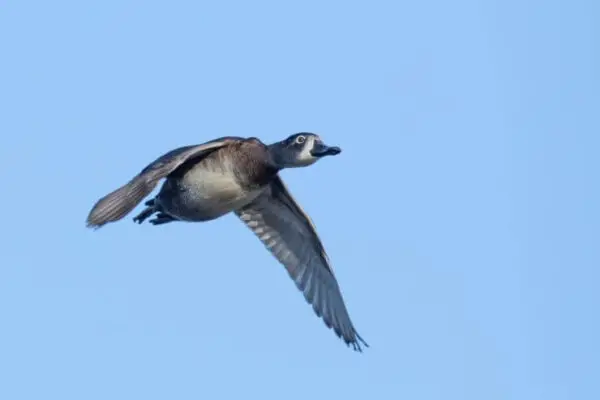
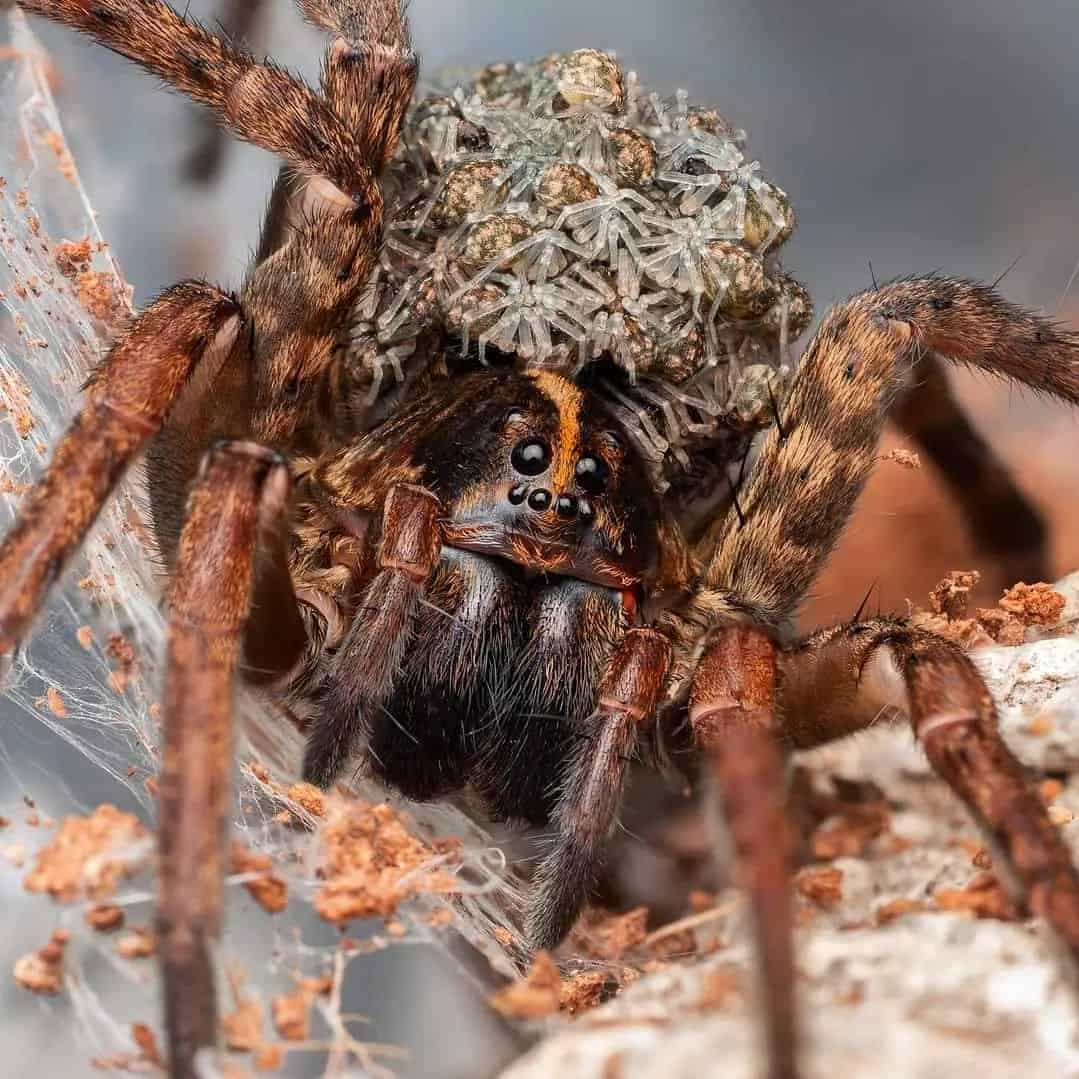

2 thoughts on “22 Species of White Birds of Prey [images + IDs]”